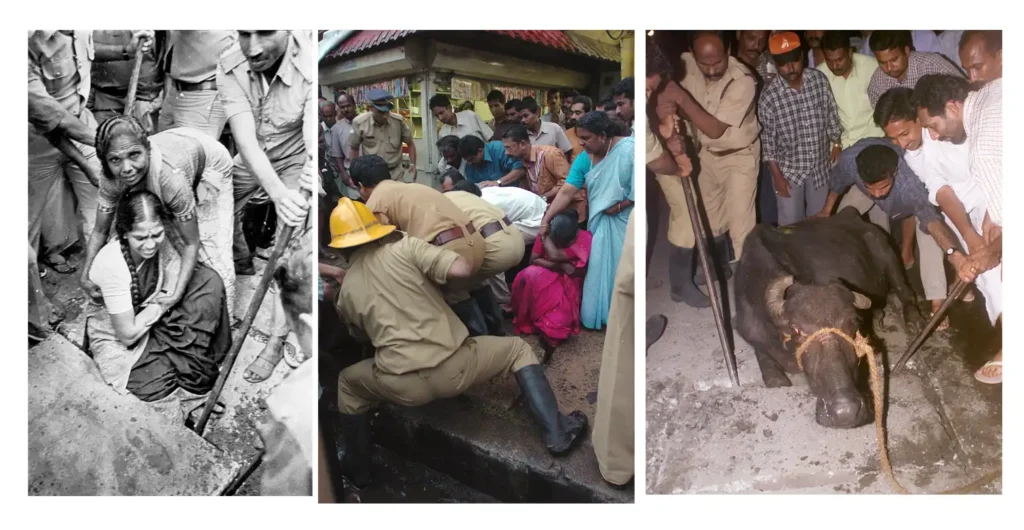
Gaps of Neglect: A Visual Investigation into Urban Infrastructure Hazards”
Introduction: The Role of Visual Journalism in Public Awareness
Photojournalism is not just about capturing moments; it is about documenting reality in a way that sparks conversation and compels action. A well-structured photo story can highlight social issues that often go unnoticed in daily life. This sequence of images does just that—it exposes the overlooked dangers posed by broken slabs and poorly maintained sidewalks, affecting both pedestrians and animals.
Each image in this series is not just a photograph but a testament to urban neglect, raising questions about civic responsibility, public safety, and municipal accountability. By visually dissecting this issue, we step into the role of a watchdog journalist, whose duty is to inform, engage, and push for change.
Framing the Issue: Why Broken Slabs Matter
Sidewalks and pedestrian pathways are integral to urban mobility, designed for safe passage. However, when these public walkways are left in disrepair, they become accidents waiting to happen. For a common pedestrian, a misstep due to a hidden gap or an unstable slab can lead to severe injuries. For animals, especially strays and cattle roaming city streets, these hazards often go completely unnoticed until an accident occurs.
This series follows a comparative approach, documenting similar infrastructural failures across different locations to illustrate that this issue is not isolated to one city, but a widespread concern.
Case Studies: Capturing the Dangers in Different Locations
📍 Trivandrum: The Invisible Peril
The first image in this sequence, taken from Trivandrum, showcases a fractured pavement with large gaps, exposing pedestrians to serious tripping hazards. The uneven surface and loose slabs are particularly dangerous for children, elderly citizens, and people with disabilities, who may struggle to navigate such pathways.
📍 Kochi City: A Step Away from Disaster
The second image, taken from Kochi, captures another severely damaged walkway—a broken slab that leaves a gaping hole in the sidewalk. These urban blind spots can result in unexpected falls, often leading to injuries that go unreported. Despite thousands of commuters using these paths daily, such hazards remain ignored due to delayed or absent municipal intervention.
📍 Thoppumpady, West Kochi: The Unseen Victims
The third image, taken in Thoppumpady, West Kochi, tells a more heart-wrenching story. A buffalo, likely foraging for food, finds itself trapped in a deep pavement gap. Unlike humans, animals do not recognize such hazards, making them even more vulnerable to poorly maintained infrastructure.
While injured pedestrians can report incidents, animals have no voice in this discourse, making it all the more critical for journalists to document and advocate for their welfare.
Journalistic Approach: The Power of Sequential Photography
For journalism students, this series serves as an example of how photojournalistic storytelling can be used to highlight an issue through:
- Contextual Framing – Each image represents a different urban setting, reinforcing that the problem is widespread, not isolated.
- Comparative Photography – Showing similar hazards in multiple cities strengthens the argument that infrastructure failures need urgent attention.
- Human & Animal Impact – The inclusion of both pedestrian and animal perspectives creates a multi-dimensional story, making the issue relatable to a wider audience.
- Call for Action – A photo story should not just inform but provoke change. A structured, fact-based narrative like this one can be used to urge civic authorities to take corrective action.
Conclusion: The Role of Journalism in Public Safety
This sequence of images stands as a visual petition for better urban planning and pedestrian-friendly infrastructure. It is the responsibility of local municipalities to ensure that public spaces remain safe and accessible, but journalists play a crucial role in bringing such issues into the public domain.
For journalism students, this serves as an important lesson in using photography as an advocacy tool. Capturing an issue is just the beginning—presenting it with compelling storytelling, backed by facts and a call for accountability, is what makes it impactful.
Through thoughtful, persistent, and ethical reporting, journalists can be the catalysts for systemic change.
📝 Final Takeaway: A single image can tell a powerful story, but a sequence of well-framed, thematic images can build a movement.
#JournalismForChange #Photojournalism #PublicSafety #Kochi #Trivandrum #UrbanNeglect #ThePowerOfPictures
